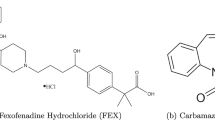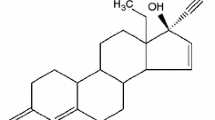Abstract
Purpose. The purpose of this work was to monitor polymorphic transformations of glycine during the drying phase of a wet granulation and model the polymorphic conversions using a time-based reconciliation model.
Methods. Near-infrared spectroscopy (NIR) was used for quantitation of polymorphs, and X-ray powder diffraction (XRPD) was used for qualitative analysis of polymorphs.
Results. The data show that the faster the granulation was dried, the more kinetic trapping of the metastable α-glycine polymorph, as predicted by reconciliation of the time scales of both the drying rate and the rate of the solution-mediated conversion.
Conclusions. By knowing basic properties of the drug substance (solubility of the polymorphic forms and the rate of the solution-mediated conversion), processing conditions, such as the drying rate, can be adjusted to anticipate and prevent potential polymorphic transformations.
Similar content being viewed by others
references
L. L. Augsburger and M. K. Vuppala. Theory of Granulation. In D. M. Parikh (ed.), The Handbook of Pharmaceutical Granualation Technology, Marcel Dekker, New York, 1997, pp. 7–8.
M. W. Y. Wong and A. G. Mitchell. Physicochemical characerization of a phase change produced during the wet granulation of chlorpromazine hydrochloride and its effects on tableting. Int. J. Pharm. 88:261–273 (1992).
M. Otsuka, H. Hasegawa, and Y. Matsuda. Effect of polymorphic forms of bulk powders on pharmaceutical properties of carbamazepine granules. Chem. Pharm. Bull. 47:852–856 ((1999)).
H. G. Brittain, K. R. Morris, D. E. Bugay, A. B. Thakur, and A. T. M. Serajuddin. Solid-state NMR and IR for the analysis of pharmaceutical solids: polymorphs of fosinopril sodium. J. Pharm. Biomed. Anal. 11:1063–1069 (1993).
P. E. Luner, S. Majuru, J. J. Seyer, and M. S. Kemper. Quantifying crystalline form composition in binary powder mixtures using near-infrared reflectance spectroscopy. Pharm. Dev. Tech. 5:231–246 (2000).
A. D. Patel, P. E. Luner, and M. S. Kemper. Low-level determination of polymorph composition in physical mixtures by near-infrared reflectance spectroscopy. J. Pharm. Sci. 90:360–370 (2001).
A. D. Patel, P. E. Luner, and M. S. Kemper. Quantitative analysis of polymorphs in binary and multi-component powder mixtures by near-infrared reflectance spectroscopy. Int. J. Pharm. 206:63–74 (2000).
G. Albrecht and R. B. Corey. Crystal structure of glycine. J. Am. Chem. Soc. 61:1087–1103.
R. E. Marsh. A Refinement of the crystal structure of glycine. Acta Cryst. 11:654–663.
Y. Iitaka. The crystal structure of γ-glycine. Acta Cryst. 14:1–10.
Y. Iitaka. The crystal structure of β-glycine. Acta Cryst. 13:35–45.
A. Peeters, C. Van Alsenoy, A. T. H. Lenstra, and H. J. Geise. Solids modeled by ab initio crystal field methods. X. Structure of α-glycine, β-glycine, and γ-glycine using a 15-molecular cluster. J. Chem. Phys. 103:6608–6614 (1995).
I. Weissbuch, L. Leisorowitz, and M. Lahav. Tailor-made and charge-transfer auxilliaries for the control of the crystal polymorphism of glycine. Adv. Mater. 6:952–956 (1994).
C. E. Miller and D. E. Honigs. Discrimination of different crystalline phases using near-infrared diffuse reflectance spectroscopy. Spectroscopy 4:44–48 (1989).
R. J. Barnes, M. S. Dhanoa, and S. J. Lister. Standard normal variate transformation and de-trending of near-infrared diffuse reflectance spectra. Appl. Spec. 43(5):772–777 (1989).
M. Falk and O. Knopp. In F. Franks (ed.), Water: A Comprehensive Treatise, Vol. 2, Plenum Press, New York, 1972, pp. 70–80.
L. G. Weyer. The use of derivative nodes in near-infrared spectroscopy, In C. S. Creaser and A. M. C. Davies (eds.), Analytical Applications of Spectroscopy, Royal Society of Chemistry, London, 1988, pp. 437–442.
J. D. Kirsch and J. K. Drennen. Near-infrared spectroscopy: applications in the analysis of tablets and solid pharmaceuticals dosage forms. Appl. Spec. Rev. 30:139–174 (1995).
A. D. Trafford, R. D. Jee, A. C. Moffat, and P. Graham. A rapid quantitative assay of intact paracetamol tablets by reflectance near-infrared spectroscopy. Analyst 124:163–167 (1999).
D. E. Honigs. Near infrared analysis. Anal. Instr. 14(1):1–62 (1985).
Author information
Authors and Affiliations
Corresponding author
Rights and permissions
About this article
Cite this article
Davis, T.D., Peck, G.E., Stowell, J.G. et al. Modeling and Monitoring of Polymorphic Transformations During the Drying Phase of Wet Granulation. Pharm Res 21, 860–866 (2004). https://doi.org/10.1023/B:PHAM.0000026440.00508.cf
Issue Date:
DOI: https://doi.org/10.1023/B:PHAM.0000026440.00508.cf




